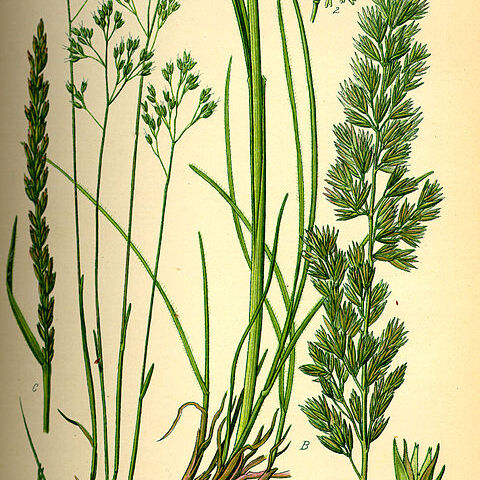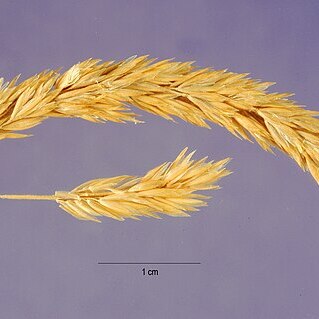Perennials, tufted, sometimes shortly rhizomatous. Culms unbranched. Leaf sheaths of tillering leaves usually closed; leaf blades mainly basal, narrow, flat, or inrolled and filiform to setaceous; ligule membranous. Inflorescence a dense spikelike panicle, shining; branches short, erect, hispidulous to woolly. Spikelets with 2 to several florets; rachilla puberulous or glabrous, disarticulating below each floret; glumes narrow, unequal or subequal, equaling or shorter than florets, strongly keeled, thinly herbaceous, 1–3(–5)-veined, margins broad, hyaline, shining; floret callus small, glabrous or very shortly hairy; lemmas membranous or papery, strongly compressed, sharply keeled, 3–5-veined, margins hyaline, shining, apex obtuse to acuminate, awnless or with a subapical mucro; palea subequaling lemma, hyaline, gaping free from lemma margins. Stamens 3. Ovary glabrous. Endosperm sometimes liquid.
Short tufted perennials, with or without rhizomes, sometimes annuals. Leaf-blades usually very narrow. Inflorescence a spike-like panicle, often lobed or interrupted, glistening. Spikelets (1–)2–8(–13)-flowered, all alike, the rhachilla produced and with or without a rudimentary lemma; glumes subequal or unequal, lanceolate, keeled, with hyaline margins, mostly subacute to acuminate; lemmas usually a little longer than the glumes, faintly 3–5(–7)-nerved with hyaline margins, usually acute to acuminate, with or without a short terminal awn; callus obscure, glabrous or almost so; stamens 3; stigmas 2.
Spikelets normally 2-fld, disarticulating above the glumes and between the lemmas; rachilla prolonged behind the second palea and occasionally bearing a third, rudimentary or fertile, or a fourth rudimentary fl; glumes unequal, obscurely keeled, scarious-margined, the first 1-veined, the second 3–5-veined; lemmas about as long as the glumes, rounded on the back, acute, scarious at margin and tip, obscurely 5-veined; palea hyaline, nearly as long as the lemma; seeds with minute embryo and liquid endosperm; lvs narrow and shining; panicles contracted, silvery-green. 20, N. Temp. and Arctic.
Spikelets very shortly pedicelled, laterally compressed, (rarely 1) 2-many-flowered, muticous or awned; florets hermaphrodite or the uppermost one more or less reduced; rhachilla disarticulating above the glumes and between the florets, produced or often terminated by a reduced lemma, pubescent or glabrous.
Lemmas almost always exceeding the glumes, 3-5 (rarely 7-)-nerved, the lateral nerves usually not very distinct, the middle nerve prominent and sometimes excurrent into a short mucro, both margins and apex hyaline; callus very short, glabrous or shortly pilose.
Inflorescence a panicle, usually more or less contracted, rarely lax and open, usually almost cylindrical, often interrupted in the lower part, glabrous or hairy.
Glumes 2, unequal to subequal, persistent, subacute to acuminate or more rarely obtuse, with hyaline margins; the inferior 1-3-nerved; the superior 3-5-nerved.
Caryopsis linear-oblong to oblong in outline, laterally compressed, of soft consistency, tightly embraced by the lemma; hilum basal, very minute.
Paleas shorter than or almost as long as the corresponding lemmas, 2-keeled, hyaline, with the apex 2-dentate.
Ovary glabrous; styles distinct, rather short; stigmas plumose, laterally exserted.
Perennials or annuals of varying habitats.
Lodicules 2, very small, hyaline.
Ligule a hyaline membrane.
Stamens 3.


